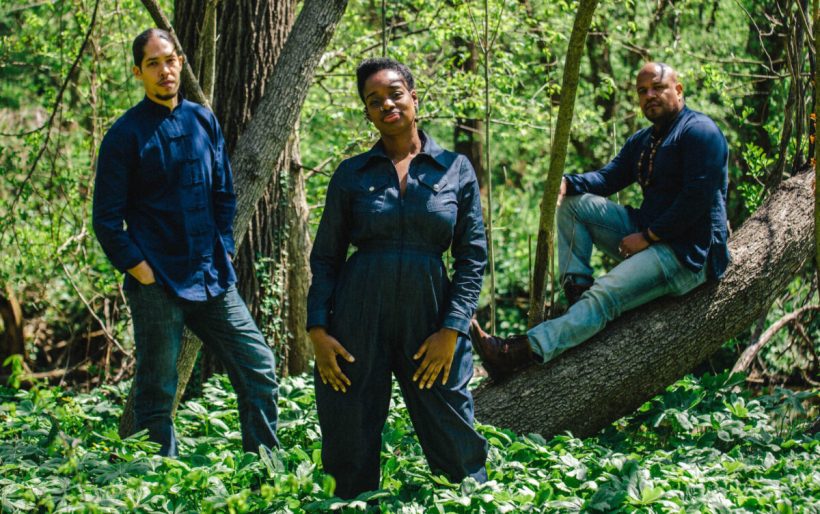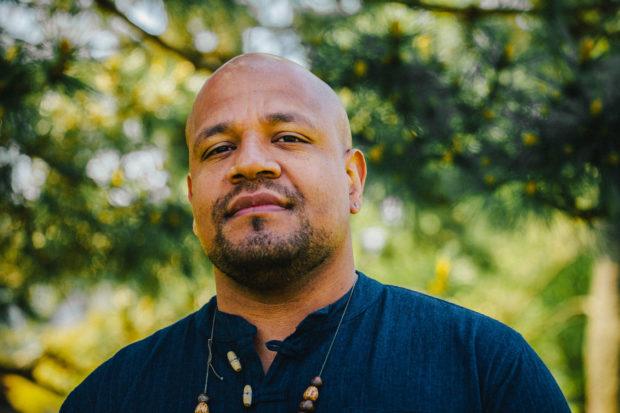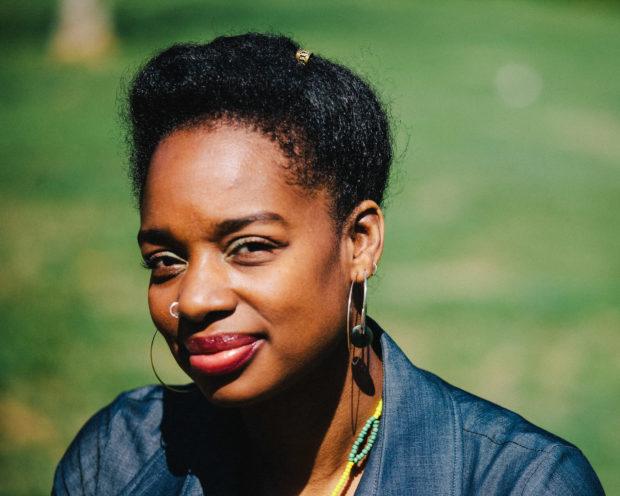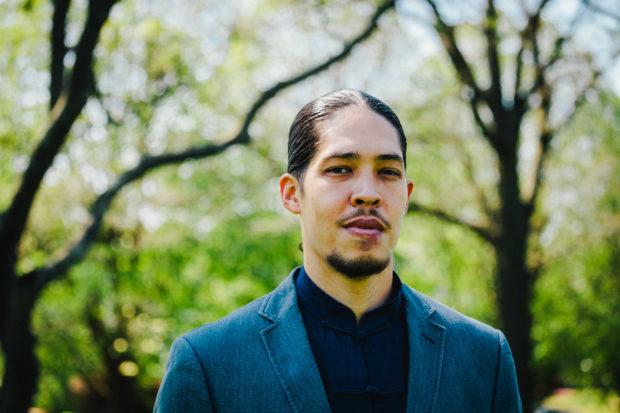
Revivals Artists | Photo by Aidan Un
World Cafe Live will host the virtual premiere of The Revivals of Blackness
World Cafe Live will be hosting the world premiere of the new multimedia performance, The Revivals of Blackness, on Thursday, June 3, at 7:30 pm. An additional showing of the film will take place on Sunday, June 6 at 7 pm. The virtual ceremony interweaves music, dance, poetry, interviews, and visuals.
In the summer of 2020, World Cafe Live approached Philadelphia-based artists Lela Aisha Jones, Luke Carlos O’Reilly, and Alex Shaw to create a piece in response to the death of George Floyd and the heightened attention to systemic racism in the U.S. Along with the help of filmmaker Adian Un, they created Revivals of Blackness. The virtual performance centers on and challenges the ways we think about Blackness, and how it intersects with ancestry, archive, ritual, and tradition.
The core creators of the piece have a long history of collaboration and involvement in the Philadelphia art scene. Jones is the founder of the ensemble FlyGround, and is known for creating emotionally intense movement-based work. O’Reilly is an award-winning pianist who has recorded multiple albums and toured with various artists. Shaw is a founding artist of World Cafe Live’s education program and the director of the ensemble Alô Brasil. He also served as the Artistic Director of Intercultural Journeys. Rounding out the all-star cast of collaborators, Un’s documentary film work has been featured at various film festivals around Philadelphia, including Blackstar Film Festival and the Philadelphia Asian-American Film Festival.
Jones, Shaw, and O’Reilly all appear in the virtual performance which combines music, movement, and interviews shot at World Cafe Live in Philadelphia with visual imagery created by Un and graphic artist Oluwafemi. Musicians Anwar Marshall (drums), Raul Cisneros (percussion), Matt Parrish (bass), Mollie Ducoste (violin), and Chris Williams (trumpet), and movement artists Patricia Peaches Jones and Fyness Mason also make an appearance.
Both the performances are free to attend with advanced registration and will be followed by a live Q&A with the creators. The livestream of Revivals of Blackness will also feature closed captioning and ASL interpretation. You can check out a trailer for the program along with a short interview with Jones, Shaw, and O’Reilly below. This interview has been edited for clarity and length.
The Key: Luke, you said, “I see my art as activism. I see my life as activism.” I was wondering what you meant by that and if you could elaborate on that idea.
Luke Carlos O’Reilly: I’ve done several projects and recordings in the past, and they’ve been successful, but I reached a point where I felt like I was just making music that didn’t have much meaning past creating a nice song or doing a remake of another song. I wanted to do something, especially around the time that Black Lives Matter really became a movement. More notice was being taken, mostly by social media about different acts of violence and killings of Black and brown folks. I also had my own encounter where I was brutalized by a police officer back in 2009. I think that was probably the point where I really considered trying to play a role in making a change. I believe that, as an artist that has a decent amount of visibility in Philadelphia and the surrounding area, it was partly my duty to take part in that activism.
I have shown interest in other areas as well, but this is the activism that feels the closest to home for me. About four years ago, I started writing a Black Lives Matter suite which turned into a residency at the Kimmel Center, which turned into an album that I released two months ago. David Bradley knew I released an album, World Cafe Live actually contributed some funding for that, so he thought it would be a good opportunity to continue that kind of work with Alex, who I’d worked with several times on other projects, and Lela who I haven’t actually had the chance to work with her often but I’ve known her for years through friendship and other works I’ve been doing. He thought it would be a good collaboration. I was teaching the last couple of years at the Kimmel Center this program called Jazz4Freedom, which is basically jazz, civil rights, and social justice combined. That had me thinking more and more about this type of material.

TK: I was going to ask something similar to Alex and Lela, do you view your art as a form of activism, as well?
Alex Shaw: A lot of the work that I have done for nearly two decades is grounded in traditions that are from the African Diaspora. A lot of these cultural traditions are rooted in resistance to oppression, are rooted in their own forms of activism, and are rooted in the preservation of culture. For me, I think being a practitioner of these forms is that it’s not only your responsibility to be conscious of the historical and social context that these forms have played in terms of building community, strengthening community, and preserving Black community and cultural knowledge, but also the role that they play to activate communities around social issues. I think it’s not enough to just learn the concepts, to just learn the rhythms, to just learn the dances. You need to then also understand the power they have in both educational and performance spaces. That has really shaped my work and my process of training, studying, performing, and teaching. To me, activism is embedded in all of that because it’s part of the lineage, it’s part of the cultural traditions from which I am very much grounded in my work.
Lela Aisha Jones: As we all know, the root of activism is to act. For me, in every room that I’m in, I’m acting on behalf of myself because I can’t be in a room and not be myself as a Black woman. It’s activism that I have two graduate degrees. It puts me in spaces, and it puts me in locations where I can make a change. If I did not have a Ph.D. or if I did not have an MFA, I could not be in certain spaces, academic spaces, some grant and funding spaces. As a dancer, there’s activism there. As a dancer, I’m not always seen as an intellectual. As a woman, you can add to that as well. You can add to it the burden of always having to prove that you have good ideas or that you can synthesize things, or that you can make good art.
I feel like in every room that I walk into, whether it’s a room that’s not mainly Black or people of color, whether it’s a room where I’m the only woman, where it’s a room where I’m the only dancer, where it’s a room where I have less knowledge about something but still want to engage in it, one of the strategies that I’m really grateful to be in development on is collaboration. I think walking into a room with folks and at least trying to listen and see where their gifts are and trying to figure out where your gifts and talents meet is where activism starts to become action that is not against something and not reactive but for something. You can’t always find the meeting place in collaboration. There’s definitely tension, and people don’t always agree. I’ve never been in a collaborative project where there hasn’t been a moment of tension.
Where someone had to rise as a leader, and someone had to step back. There are all these sorts of things that become unclear when you try to work together in those ways, but I think working together in those ways, especially in artistic and organizing work parallels some of the activist organizing work that you have to do. You’re able to negotiate and to listen, and to find each other’s gifts. So yes, I think my whole life has been activism. My parents wanted me to have an education that was their activist practice. Being in this country and being free was the beginning of activism generations ago in my family. There’s no place I can go in this country where I have not been engaged in activism since before I was born.

TK: What was that collaborative process like? What was the dynamic like between you three and as well as the other artists you worked with?
LCOR: Alex and I did a lot of arranging musically just because it’s kind of difficult with schedules to get all three of us in the same place at the same time on a regular basis. We almost had four different approaches to this. There was the approach of a song that I had written and offered, a song that Alex offered, a song that Lela offered, and then there were songs that we all had written together. It’s very kind of complicated in a way because there were just so many different ways we went about it, but that’s what felt most natural to us. Sometimes it just made sense. Lela would be like, hey this song is mostly music so y’all get together or if there was a song that was more associated with movement, she might work on it and present it to us.
LAJ: I want to say it expands to our networks, our families, our communities of people. You can see how it starts with us, but it’s like a web. It keeps spreading out across all of the people who we think have these beautiful offerings that are appropriate for the moment and the collaboration. I will say that there’s a learning period. At some point, you’ve got to be like, yo, maybe this isn’t the right direction or maybe this isn’t my field where I can be involved. You have to figure out where your hands and your heart belong in the moment and in the timeframe. You have to figure out where you can be most useful and most optimal in your offerings.
TK: Going off that idea of community, what did working on this project mean to you, and what do you hope it will mean to the community?
AS: I think for me, for all of us, but speaking for myself, this has certainly been a big growing period artistically to be able to collaborate in this way as Lela had spoken about before. Really to find and activate so many ways of engaging my work, my compositional practice, my performance practice with these other artists. It’s been really enriching, challenging, of course, but definitely enriching. We’re really proud of what is coming out of this. In some ways, it feels next level for all of us. It’s something that none of us could have created on our own it’s really coming together that made this possible.
For the community, I think what’s interesting is, as Lela has mentioned before, we are parts of many different community networks. We’re part of the Philadelphia artists community, we’re part of different global communities, African Diaspora communities. What I think is interesting about this project is it’s a way to bring together all of these different community spaces that we have, because it’s virtual, it’s not just a hyper-local Philadelphia thing. Although we are based in Philly it’s really exciting that we have an opportunity to connect or reconnect with more global communities, communities on the continent of Africa, communities that are in Brazil, communities in Cuba, etc, across the United States and Europe. I’m hoping that this work serves as a form of inspiration, as a provocative composition piece.
Of course, we would want people to be moved and entertained. I would say it’s a very moving work. Hopefully, it will allow for some reflection for other people. It will offer a space for other people to think about ways in which they can engage and maybe look at themselves and their own work or their own non-work, depending on where you are. That’s what we’re hoping. We’re hoping that this project will make people realize new possibilities, new possibilities through our artistry and new ways of engaging with these issues, new ways of engaging with these feelings, engaging with this history, and engaging with new possibilities for the future.

LAJ: I just think about the time that we’re in and our society. I always have desires in my heart because I think we’ve figured out how to be kind on the surface and to talk a good game about humanity, but we haven’t figured out how to reconcile our history of inhumane treatment of people. We haven’t figured out how our culture of extreme productivity, capitalism, and commodification have interrupted our relationship with the natural environment and being in reciprocity with all of these things. Not just humans, but what we do in the world is an extension of how we treat each other. We treat everything how we treat each other. Those desires of humanity and beyond, reciprocity with the natural environment, are themes that come up in this work. My desires are always my desires; that I contribute a raindrop or a drop of sand or something to every space that I walk in.
I have to be honest; I don’t know if I’m concerned about this country as an institution doing the right thing, but my life offering in general on a daily basis is to see if I can get folks to see each other and the natural environment as more than something that serves us. That people are not brought into your life to do things for you and make you better. We started this country that way, right? Black folks were brought here to do things for other people. They were brought here by white people to do things for them. The Indigenous folks were expected to accommodate the colonists, and if they didn’t, they were killed. We know this history; it’s not a new history. The idea that we’re past that, if you just look at every day, yeah there’s some kind gestures — someone might bring you a pie, have a drink with you whatever — but we still are dealing with an extreme amount of violence. We still are dealing with an extreme amount of racism, gender discrimination, sexism, gaps in economic structures, and accessibility issues.
That, to me, goes back to the root of not really being able to see each other. I guess the answer to that question is that this project is an extension of my life. I don’t know if there’s a way for it not to be. If you’re living in your life’s work, in your life’s practice, if you’re living in your lane, or as many lanes as you may need to occupy, if you’re living in your heart, if you’re living in what you believe in and what you feel like you have to offer, why you’re here, and what you have to receive then the projects you do are just an extension of that.
TK: Alex, you said, “this work is everybody’s labor to hold Blackness in the way Blackness holds so many others.” Can you tell me more about that idea and how it influenced the work you did on this project?
AS: Sure, I was sort of speaking from my own experiences in lots of different spaces and thinking about the ways in which I’ve been received and the ways in which I’ve been supported and helped both in the care of people and in the care of tradition. I think that by virtue of the social histories that we have, Blackness and Black communities have had to accommodate, have had to receive, have had to absorb, have had to integrate and synthesize in all kinds of ways that continue to censor family and community. I think that the complete connection and reconnection with tradition with cultural practice is something that I think aligns with building community.
I think in those ways, I’m thinking about how Blackness holds everyone. To your question about everyone’s labor, I think this is really hard work. This is not just about reading one book, this is not just about having one conversation. This is really about how you engage every day and how you treat other people. Especially if you are one to be blessed with certain kinds of privileges, certain kinds of social privileges, or white privilege what are your responsibilities that go along with that privilege to engage in this change? That starts with yourself and those closest to you. It’s not just to place the burden on those who have been historically marginalized, oppressed, etc. This is not the work of just people of color this is work that everyone should be engaging in if we want to really see change across society. That’s part of what I think is informing that statement of this is everyone’s labor, particularly those who have privilege, who have access to structures of power. How do those changes come into play to help uplift people who have historically not benefited from these privileges, who have actively been oppressed?
LAJ: The only thing that I would add is just that if you’re in a family, like an unchosen family — which I kind of feel like the United States is sometimes; like there’s a lot of people here that are choosing to be here, but we’re not choosing each other per se — but when you’re in a situation, an unchosen family, and you have to co-exist, there are rises. You can even think about it in one-on-one relations there are moments when the care and love have to rise, where the activism has to rise, and something else has to fall, where space for growth has to rise for somebody else. When you’re in relationships, there’s that reciprocal exchange. It doesn’t mean that you’re equally in the same place all of the time.
In a time like this, I hope that this project validates that imbalance and affirms some folks. I hope it washes them in love and care and allows them to be rejuvenated so that they can go take that love and care out. I hope for some folks it offers an awakening, a re-remembering of maybe what your essence is, your ashe as we say, your life force, your life offering in the world which is not of course one thing, we know that. I think ultimately just thinking about when you need love, when you need care, [and] when you need to act. Periods of having to do really hard work and periods of needing care and love. So if one group of people has been doing the loving, the caring, the nurturing for ages, somebody else needs to step up. You can’t keep asking.
In a one-on-one relationship, it’s the same thing. In a family, it’s the same thing. Somebody is carrying the weight. Somebody else has gotta lift it at some point, and that means they’ve got to carry the weight for a while. Then maybe at some point, you come to equity which is maybe carrying the weight together in equitable ways, not equal ways. I’m not sure where we’re going, but I do think this project is an offering to keep us in dialogue about love, care, activism, artistry, and the sacred art of making together that helps us through.
The Revivals of Blackness’ virtual premiere takes place Thursday, June 3rd, at 7:30 p.m. via World Cafe Live’s livestream. Get more details and RSVP here.